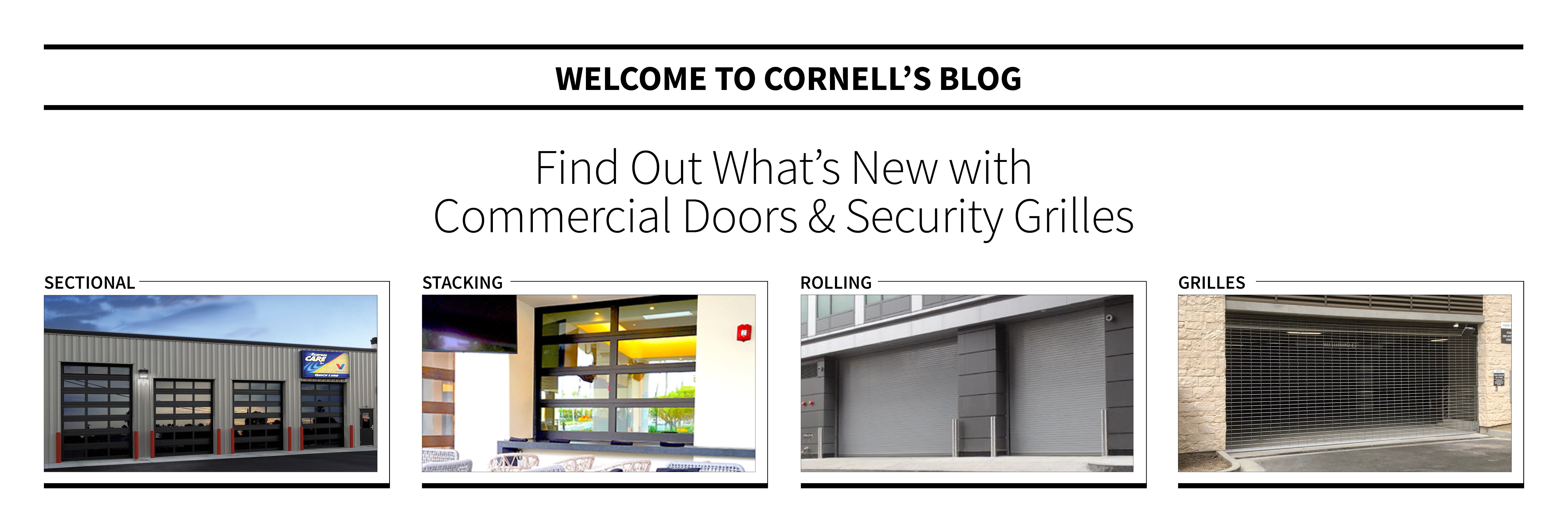

Cornell Commercial Rolling Doors and Security Grilles Blog
When it comes to Overhead Rolling Doors and Grilles, we are the experts in innovative door solutions!
Subscribe
Get updates on new blog posts to your inbox!
Protect Your Building Against High Winds & Hurricanes
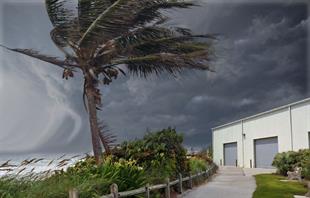
Strong winds rip down empty streets, destroying everything in their path. Floods ruin homes and businesses. Rip currents rage in the oceans along the coast. Sound like a scene from a nightmare? It is, and during a hurricane, it is an unfortunate, scary reality for many.
In this situation, the last thing you want to be thinking about is if your rolling doors will hold up under wind pressure of anywhere from 74 to 180 miles per hour. Because any opening in a building is a natural pressure point in a hurricane, closures and doors must be manufactured to withstand these strong winds. Thankfully, rolling doors are classified by wind load to help you choose the strongest ones needed for your building. Let’s take a closer look at the options.
What is Wind Load?
Wind load is defined as “the force on a structure arising from the impact of wind on it.” In its simplest terms, this measurement is the pressure the wind places on your building at a specified velocity. Higher velocity translates directly into increased wind load.
Wind load is separated into two categories: “dead” and “live.” Dead load is the total rolling door hang weight and is constant. Live load includes wind pressure forces and is not constant. Wind load moves to overhead door guides and wall angles from closed commercial garage doors when they’re closed.
Additional header supports are not usually required for overhead rolling doors because they are supported by a guide assembly. But with dead and live wind load, sometimes there are extenuating circumstances.
In the case where a dead load would need extra support, critical wall fasteners (called top fasteners) can be added above the rolling door opening.
In a live load, the critical wall fasteners are called side fasteners. They go along the opening height or side of the rolling door. Static wind loaded doors secure the curtain within the guides when in the closed position to prevent the door from blowing out due to high wind speeds. Live loads can drastically impact how well a hurricane garage door can hold up under pressure.
Take this into consideration — a 10x10 non-insulated door weighs around 1000 lbs. With a 40 pounds per square foot (psf) live wind load, the pressure and weight on the door jambs would increase to 2500 pounds, more than double the original door’s weight!
How to Specify Your Rolling Garage Door
Strong hurricane winds are damaging, so you might be tempted to specify the maximum wind speed to make sure your hurricane-rated doors are up to task. But that’s not the only factor to consider when specifying your rolling door. There are other factors that play a role in determining your door’s design wind load. Combining the wind speed needed for your door (the first factor below) with the others can give you an almost foolproof way to ensure you’re specifying the correct rolling garage door for your facility.
- Wind speed
- Mean roof height
- Roof slope
- Surrounding topography
- Exposure category
- Directionality factor
- Door area
- Importance factor
- Zone
- Positive or negative pressure
- Internal building pressure
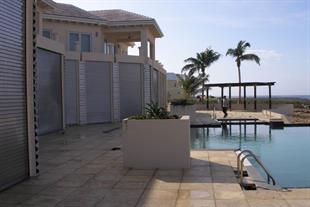
Wind speed and the size of the overhead door are very important factors when selecting a commercial roll up door. But the other factors can be just as important in making your choice. If one item above is changed throughout the process, this also means that the design wind load can change.
Combining these wind load door factors gives you the required psf of a garage door, which is helpful to know when you need to know how your door will hold up in wind gusts or prolonged periods of wind.
The factors above are used to determine a door’s design wind load — needed for when wind can cause structural damage or concerns. There’s a flip side to this coin called test wind load, explained below.
Design wind load vs. test wind load
Test wind load is defined as the engineered limit of a rolling door’s capacity. It is also sometimes referred to as “ultimate wind load.” Proof of performance of your door’s design wind load and test wind load is typically required by building codes. Your test wind load should be 1.5 times the specified design wind load. So if you have a 30 psf design wind load for your door, the test wind load should be 45 psf for your rolling hurricane garage doors.
Is There a Typical Hurricane Garage Door?
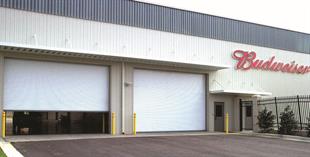
There isn’t a one-size-fits-all approach to hurricane garage doors, but overhead coiling doors can typically resist up to 20 psf wind load.
The specific location of your structure significantly impacts the type of door you'll need, since codes vary among municipalities. For example, Florida has three separate zones:
- High-velocity hurricane zone (HVHC) where doors must meet a large missile impact rating
- Wind-borne debris areas where robust protection is mandated
- Standard areas where requirements are less strict
Similar regulations exist in other hurricane-prone areas but can differ depending on the anticipated sustained wind speeds a door must resist. Those speeds generally decrease the farther inland a property lies and also vary based on the additional property factors listed above, such as topography and exposure zone.
A requirement of anything over 20 psf for a commercial garage door will include additional wind load constructions (which should be mentioned when ordering). Items included in additional wind load constructions are:
- Windlocks — iron castings riveted to the door’s slat ends to prevent the door curtain from leaving the guides
- Windlock fasteners — help to secure the windlocks even more, may be heavier and stronger
- Guide angle assemblies — the door guide and a wall mounting angle, usually heavier and stronger with closer bolt spacing for hurricane garage doors
- Windlock bars — a flat bar welded to the inner angle of the guide assembly for the engagement of windlocks under the wind load; retains the curtain in the guides
Additional wind load constructions are an extra line of defense for your door, door guides, and curtain in a hurricane. Some people may assume a heavier gauge is better to protect a rolling door in an extreme weather situation and increase wind load capacity. However, a heavier gauge can actually negatively affect the windlocks by increasing the dead and live loads on the door. If the dead and live loads are put under pressure by a heavier gauge door, the door can blow out.
Don’t make your hurricane garage doors another item on the list of worries when a hurricane is coming. Choose doors with the correct wind load!
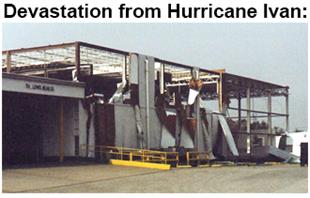
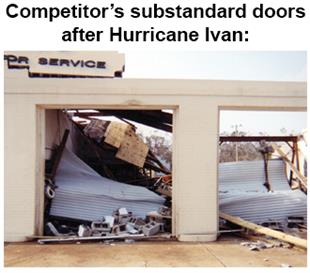
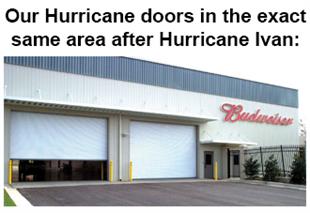
What are the benefits of hurricane-resistant garage doors?
Garage doors engineered and rated for hurricane resistance offer many benefits during the weather event and year-round.
Advantages during the storm
When a hurricane bears down, your garage doors can be a vulnerable point in your building envelope. A malfunction can easily let wind or debris enter your structure and cause additional property loss.
Durable wind- and hurricane-resistant doors are your first line of defense and help prevent unnecessary out-of-pocket expenses from wind damage. They're specifically designed to withstand these temporary high winds while staying in place. Manufacturers even make some models that can operate in higher wind loads of up to 20 psf.
Doors that are specially engineered for installation in storm-prone areas can often hold up against impacts associated with flying debris. This design offers increased peace of mind about your door's protection levels. The impact resistance also helps you comply with local building codes in areas that require it.
Benefits throughout the year
Modern weather-rated garage doors combine function with beauty, allowing them to be an aesthetic component of your building's exterior. You can use them to create a unique look, showcase your branding, or increase your structure's curb appeal.
Additionally, hurricane-resistant doors can feature upgrades like insulation that boost your building's energy efficiency and provide a more comfortable interior temperature. They also help provide physical security to protect your property, people, and products.
Installing impact- and hurricane-rated garage doors may help you secure lower property insurance premiums. Your insurance carrier can help you determine any potential savings you could enjoy.
Contact us for wind-rated doors
Cornell is the industry-leading rolling door, security grille, and closure product experts since 1828. To inquire how Cornell's long history of innovation and customer service can help you with your next rolling door project, call (800) 233-8366!

Cornell is the industry leading rolling door, security grille and closure product experts since 1828. To inquire how Cornell's long history of innovation and customer service can help you with your next rolling door project, call 1-800-233-8366!





